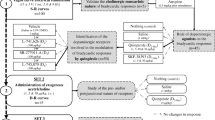Summary
The influence of (+)- and (−)-oxaprotiline (OXA) given repeatedly on the behavioural effects mediated by α1 and α2-adrenoceptors as well as on the binding to brain α1-adrenoceptors was studied. (+)-OXA given repeatedly for 14 days (but not 3 or 7 days) enhanced exploratory hyperactivity of rats induced by methoxamine injected intracerebroventricularly; (−)-OXA given for 3, but not 7 or 14 days, increased the methoxamine-induced exploration in rats. The locomotor hyperactivity induced in mice by d,1-threo-3,4-dihydroxyphenylserine was increased by repeated (14 days) (−)-OXA but not (+)-OXA. Neither OXA enantiomers given repeatedly modified the clonidine-induced locomotor hypoactivity in mice. Both enantiomers given repeatedly did not change the binding of [3H] prazosin to aradrenoceptors (Bmax, KD) in the thalamus and hippocampus. Repeated (+)-OXA increased the affinity of α1adrenoceptors for phenylephrine in the cortex, thalamus and hippocampus. A similar effect of (−)-OXA was observed in the hippocampus only.
The results indicate that both OXA enantiomers are able to enhance the responsiveness of brain α1-adrenergic system, probably via the increase in the affinity of α1-adrenoceptors for their agonists.
Similar content being viewed by others
References
Bijak M (1988) Neurophysiological evidence for antidepressant-induced supersensitivity of hippocampal α1-adrenergic receptors. Psychopharmacology 96 [Suppl]: 285
Campbell IC, McKernan RM (1982) Central and peripheral changes in α-adrenoceptors in the rat after chronic tricyclic antidepressants. Br J Pharmacol [Suppl 75]: 100P
Checkley SA, Thompson C, Burton S, Franey C, Arendt J (1985) Clinical studies of the effect of (+)- and (−)-OXA upon noradrenaline uptake. Psychopharmacology 87: 116–118
Clineschmidt BV, Flataker LM, Faison E, Holmes R (1979) An in vivo model for investigation α1- and α2-receptors in the CNS: studies with mianserin. Arch Int Pharmacodyn Ther 242: 59–76
Delini-Stula A, Vassout A, Hauser K, Bittiger H, Buech O, Olpe HR (1983) OXA and its enantiomers: do they open new avenues in the research of the mode of action of antidepressants? In: Usdin E, Goldstein M, Georgotal A (eds) Frontiers in neuropsychiatric research. MacMillan, London, pp 121–134
Heal DJ (1984) Phenylephrine-induced activity in mice as a model of central α1-adrenoceptor function. Effects of acute and repeated administration of antidepressant drugs and electroconvulsive shock. Neuropharmacology 23: 1241–1251
Herman ZS (1970) The effects of noradrenaline on rats behaviour. Psychopharmacology (Berlin) 16: 369–374
Janssen PAJ, Jagenau AHM, Schellekens KHC (1960) Chemistry and pharmacology of compounds related to 4-(4-hydroxy-4-phenylpiperidino)-butyrophenone. Part IV. Influence of haloperidol (R-1625) and chloropromazine on the behaviour of rats in an unfamiliar open field situation. Psychopharmacology (Berlin) 1: 389–392
Klimek V, Maj J (1988) Antidepressant drugs given repeatedly increase the α1-adrenoceptor agonist affinity. Psychopharmacology 96[Suppl]: 285
Kopanski C, Turck M, Schultz JE (1983) Effects of long-term treatment of rats with antidepressants on adrenergic-receptor sensitivity in cerebral cortex: structure activity study. Neurochem Int 5: 649–659
Maj J, Klimek V, Nowak G (1985) Antidepressant drugs given repeatedly increase binding to α1-adrenoceptors in the rat cortex. Eur J Pharmacol 119: 113–116
Maj J, Mogilnicka E, Klimek V, Kordecka-Magiera A (1981) Chronic treatment with antidepressants: potentiation of clonidine-induced aggression in mice via noradrenergic mechanism. J Neural Transm 52: 189–197
Maj J, Mogilnicka E, Kordecka-Magiera A (1980) Effects of chronic administration of antidepressant drugs on aggressive behavior induced by clonidine in mice. Pharmacol Biochem Behav 13: 153–154
Maj J, Przegalinski E, Mogilnicka E (1984) Hypotheses concerning the mechanism of action of antidepressant drugs. Rev Physiol Biochem Pharmacol 100: 1–74
Maj J, Rogóż Z, Skuza G, Sowińska H (1982) Effects of chronic treatment with antidepressants on aggressiveness induced by clonidine in mice. J Neural Transm 60: 273–282
Maj J, Rogóż Z, Skuza G (1983) (+)-Oxaprotiline but not (−)-oxaprotiline given chronically potentiates the aggressive behaviour induced by clonidine. J Pharm Pharmacol 35: 180–181
Maj J, Rogóż Z, Skuza G (1989) Antidepressant drugs given repeatedly increase the behavioural effects of methoxamine. Hum Psychopharmacol 4: 65–70
Menkes DB, Aghajanian GK (1981) α1-Adrenoceptor-mediated responses in the lateral geniculate nucleus are enhanced by chronic antidepressant treatment. Eur J Pharmacol 74: 27–35
Menkes DB, Aghajanian GK, McCall RB (1980) Chronic antidepressant treatment enhances α-adrenergic and serotonergic responses in the facial nucleus. Life Sci 27: 45–55
Menkes DB, Aghajanian GK, Gellager DW (1983) Chronic antidepressant treatment enhances agonist affinity of brain α1-adrenoceptors. Eur J Pharmacol 87: 35–41
Mishra R, Gillespie DD, Lovell RA, Robson RD, Sulser F (1982) Oxaprotiline: induction of central noradrenergic subsensitivity by its (+)-enantiomer. Life Sci 30: 1747–1755
Mogilnicka E, Zazula M, Wedzony K (1987) Functional supersensitivity to the α1-adrenoceptor agonist after repeated treatment with antidepressant drugs is not conditioned by β-down-regulation. Neuropharmacology 26: 1457–1461
Nowak G, Przegalinski E (1988) Effect of repeated treatment with antidepressant drugs and electroconvulsive shock (ECS) on3H-prazosin binding to different rat brain structures. J Neural Transm 71: 57–64
Pawłowski L, Mazela H (1986) Effects of antidepressant drugs, selective noradrenaline- or 5-hydroxytryptamine uptake inhibitors, on apomorphine-induced hypothermia in mice. Psychopharmacology 88: 240–246
Stockmeier CA, McLeskey SW, Blendy JA, Armstrong NR, Keller KJ (1987) Electroconvulsive shock but not antidepressant drugs increases α1-adrenoceptor binding sites in rat brain. Eur J Pharmacol 139: 259–266
Vetulani J, Antkiewicz-Michaluk L, Rokosz-Pelc A (1984) Chronic administration of antidepressant drugs increases the density of cortical3H-prazosin binding sites in the rat. Brain Res 310: 360–362
Waldmeier PC, Baumann PA, Hauser K, Maitre L, Storni A (1982) Oxaprotiline, a noradrenaline uptake inhibitor with an active and inactive enantiomer. Biochem Pharmacol 31: 2169–2176
Wendt G(1988) Levoprotiline — clinical therapeutic efficacy and tolerability. Psychopharamacology 96 [Suppl]: 13
Wedzony K, Rogóż Z, Skuza G, Maj J (1988) Antidepressants given repeatedly increase the behavioural effects of methoxamine, an α1-adrenoceptor agonist. Psychopharmacology 96[Suppl]: 284
Author information
Authors and Affiliations
Rights and permissions
About this article
Cite this article
Maj, J., Weçdzony, K., Klimek, V. et al. Oxaprotiline enantiomers given repeatedly and brain α-adrenoceptors. J. Neural Transmission 80, 213–223 (1990). https://doi.org/10.1007/BF01245123
Received:
Accepted:
Issue Date:
DOI: https://doi.org/10.1007/BF01245123



